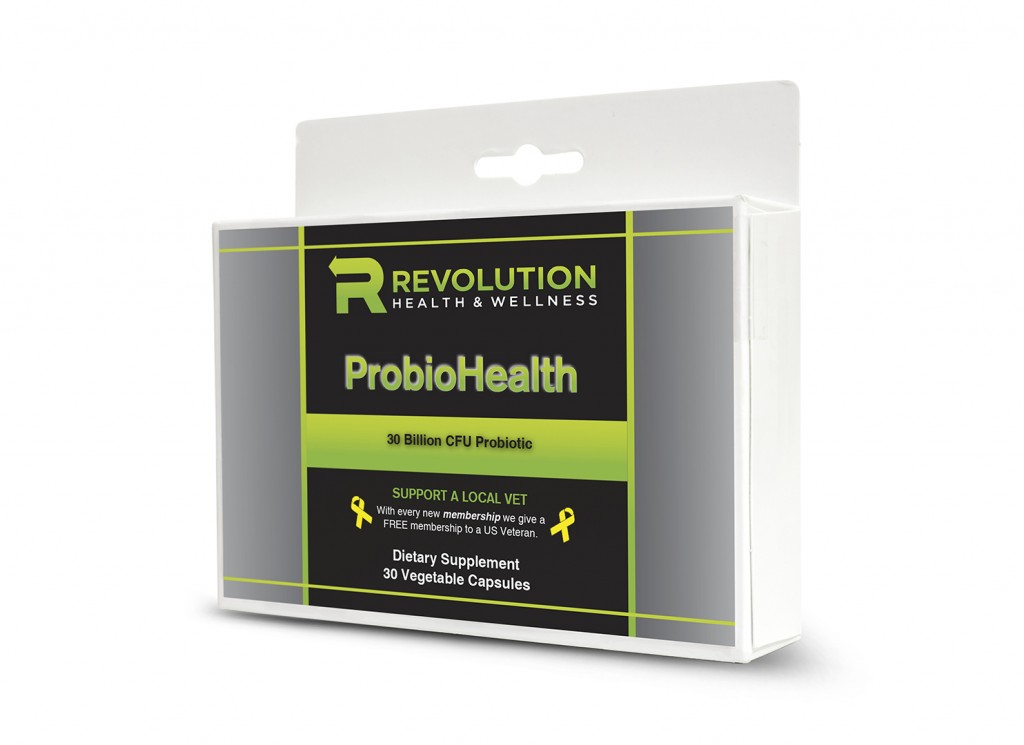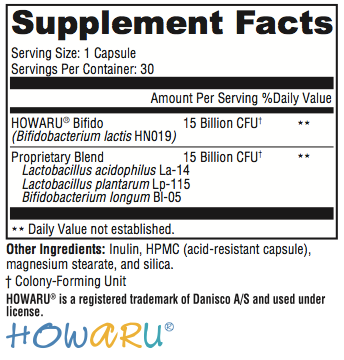Probiotics Are Good But Which One Should I Take?
Patients often ask us what they should be taking. In the absence of a specific deficiency or medical condition we generally recommend all patients take:
- Revolution Nutrients (daily multi-vitamin)
- OmegaHealth (Omega-3s with EPA/DHA)
- ProbioHealth (probiotics)
Supplementation with probiotics has many mechanisms of action that benefit health, including but not limited to:
- supporting metabolic activity, such as the production of short-chain fatty acids and vitamins, nutrient absorption, and digestion of lactose
- adhering to intestinal epithelial cells to help maintain a healthy balance of organisms in the intestinal tract
- helping to establish populations of good bacteria after disruption in balance
- supporting immune function
- promoting intestinal epithelial cell survival
- supporting healthy bowel function
- degrading oxalates [1-8]
You can go to any health food store and see tons of different probiotics. Some are refrigerated, some aren’t. Some have a single strain, some have 20. Some have millions of Colony-Forming Units (CFUs) and some have billions.
So, which ones should you be taking?
We believe it is extremely important to make sure that you are getting good value for your money and probiotics are definitely one of those things that is worth the price to get a good one!
First, the bacteria is probiotics should actually bind to the intestinal wall. You should look for human derived strains of bacteria. You will know these because they will be specific strains that have been studied and indicated by a letter/number combination identifying the specific strain.
Next, look for a good everyday probiotic with a good number of different strains. We have lots of different bacteria in our gut and a good balance of them is extremely important.
It is also important to get a high number of CFUs. The actual number of CFUs will vary from patient to patient based on their specific condition. For example, we have some patients with inflammatory bowel disease and they frequently do very well with 100 billion (or more) CFUs per day. There are several conditions that require a higher dose of probiotics.
Most probiotics should be taken with food because the food will lower the acid content (raise the pH) and help increase their survival through the stomach & small intestine so that they arrive intact to their destination in the lower portion of the small intestine and colon. However, very high quality probiotics may have a capsule designed to survive the low pH of stomach acid.
Introducing…
ProbioHealth
Common challenges associated with probiotic supplementation are maintaining stability of the organisms during distribution and shelf life and, once taken by a consumer, survival of the organisms as they travel through the digestive tract so that they reach the target tissue (intestines) alive.
To help ensure stability, Revolution Health & Wellness Clinic packages the ProbioHealth capsules in sealed, nitrogen-purged aluminum blister packs to serve as protection from factors proven to compromise the stability of probiotics, such as heat, moisture, and oxygen.
Careful selection of organisms is another way Revolution Health & Wellness Clinic helps ensure stability. Careful organism selection, as performed for ProbioHealth, is also a critical aspect of supporting digestive survival. To further support resistance to low pH and the delivery of microorganisms to the small intestines, Revolution Health & Wellness Clinic employs DRcaps gastro-resistant capsules. These specially designed, innovative capsules help slow exposure of actives to stomach acid to promote a more targeted release.
HOWARU (Bifidobacterium lactis HN019) – Discovered in 1899, B. lactis play a key role in the human microflora throughout a person’s life. Researchers have identified strain HN019 as having excellent probiotic potential based upon its ability to survive the transit through the human gastrointestinal tract, adhere to epithelial cells, and proliferate.[6] B. lactis HN019 has been extensively studied, and its safety and effectiveness is well accepted.[7,8]
To assess the impact of Bifidobacterium lactis HN019 supplementation on whole-gut transit time in adults, 100 subjects were given daily doses for 14 days of 17.2 billion colony-forming units (CFU), 1.8 billion CFU, or placebo. Decreases in mean whole-gut transit time over the 14-day study period were statistically significant in the high-dose group and the low-dose group, but not in the placebo group.[8] This level of dosing also supported other parameters of healthy GI function, as were self-reported by patient survey.[8]
In another study of preschool-age children, supplementing milk for one year with 1.9 x 10 CFU per day B. lactis HN019 and 2.4 g/day of prebiotic oligosaccharides supported both healthy iron status and weight gain.[9]
In a randomized, double-blind, placebo-controlled human dietary intervention study in elderly subjects (>60 yrs.), supplementary B. lactis HN019 resulted in statistically significant increases in the beneficial organisms bifidobacteria and lactobacilli.[10]
Lactobacillus acidophilus (Lactobacillus acidophilus La-14) – This common inhabitant of the human mouth, intestinal tract, and vagina, is also found in some traditional fermented milks (e.g., kefir) and is widely used in probiotic foods and supplements. It has a history of safe human consumption. The L. acidophilus La-14 strain is of human origin and has been identified as a type A1 L. acidophilus. L. acidophilus shows excellent adhesion to human epithelial cell-lines.[11,12]
Lactobacillus plantarum (Lactobacillus plantarum Lp-115) – This bacteria was isolated from plant material and is abundantly present in lactic acid-fermented foods, such as olives and sauerkraut. In vitro studies have shown that L. plantarum strain Lp-115 has excellent adhesion to epithelial cell lines.[13] In addition, L. plantarum is resistant to low pH conditions and survives the presence of bile at duodenal concentrations.[13,14]
Bifidobacterium longum (Bifidobacterium longum Bl-05) – The B. longum Bl-05 strain is well accepted as safe for human consumption. B. longum is resistant to low pH and bile salts and is well suited to the intestinal environment.[14]
References:
- Vanderpool C, Yan F, Polk DB. Mechanisms of probiotic action: Implications for therapeutic applications in inflammatory bowel diseases. Inflamm Bowel Dis. 2008 Nov;14(11):1585-96. [PMID: 18623173]
- Abratt VR, Reid SJ. Oxalate-degrading bacteria of the human gut as probiotics in the management of kidney stone disease. Adv Appl Microbiol. 2010;72:63-87. [PMID: 20602988]
- Masood MI, Qadir MI, Shirazi JH, et al. Beneficial effects of lactic acid bacteria on human beings. Crit Rev Microbiol. 2011 Feb;37(1):91-98. [PMID: 21162695]
- Turroni S, Vitali B, Bendazzoli C, et al. Oxalate consumption by lactobacilli: evaluation of oxalyl-CoA decarboxylase and formyl-CoA transferase activity in Lactobacillus acidophilus. J Appl Microbiol. 2007 Nov;103(5):1600-09. [PMID: 17953571]
- Shu Q, Lin H, Rutherfurd KJ, et al. Dietary Bifidobacterium lactis (HN019) enhances resistance to oral Salmonella typhimurium infection in mice. Microbiol Immunol. 2000;44(4):213-22. [PMID: 10832963]
- Gopal P, et al. Effects of the consumption of Bifidobacterium lactis HN019 (DR10TM) and galacto-oligosaccharides on the microflora of the gastrointestinal tract in human subjects. Nutr. Res. 2003;23:1313-28. http://www.daniscosupplements.com/clinical-study-bibliography.html. Accessed June 24, 2011.
- Danisco. Clinical study bibliography & abstracts. HOWARU Bifido – Bif. lactis HN019. http://www.daniscosupplements.com/clinical-study-bibliography.html. Accessed June 24, 2011.
- Waller PA, Gopal PK, Leyer GJ, et al. Dose-response effect of Bifidobacterium lactis HN019 on whole gut transit time and functional gastrointestinal symptoms in adults. Scand J Gastroenterol. 2011 Sep;46(9):1057-64. [PMID: 21663486]
- Sazawal S, Dhingra U, Hiremath G, et al. Effects of Bifidobacterium lactis HN019 and prebiotic oligosaccharide added to milk on iron status, anemia, and growth among children 1 to 4 years old. J Pediatr Gastroenterol Nutr. 2010 Sep;51(3):341-46. [PMID: 20601905]
- Ahmed M, Prasad J, Gill H, et al. Impact of consumption of different levels of Bifidobacterium lactis HN019 on the intestinal microflora of elderly human subjects. J Nutr Health Aging. 2007 Jan-Feb;11(1):26-31. [ 17315077]
- Greene JD, Klaenhammer TR. Factors involved in adherence of lactobacilli to human Caco-2 cells. Appl Environ Microbiol. 1994 Dec;60(12):4487-94. [PMID: 7811085]
- Kleeman EG, Klaenhammer TR. Adherence of Lactobacillus species to human fetal intestinal cells. J Dairy Sci. 1982 Nov;65(11):2063-69. [PMID: 7153393].
- Collado MC, Meriluoto J, Salminen S. Role of commercial probiotic strains against human pathogen adhesion to intestinal mucus. Lett Appl Microbiol. 2007 Oct;45(4):454-60. [PMID: 17897389]
- Ding WK, Shah NP. Acid, bile, and heat tolerance of free and microencapsulated probiotic bacteria. J Food Sci. 2007 Nov;72(9):M446-50. [PMID: 18034741]








